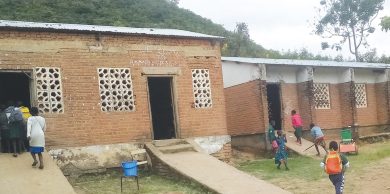Irrigation pays big
A dozen heads of cattle. A dozen houses. Eight plots. A two-tonne lorry. A grinding mill. Two oxcarts. Two motorcycles. Eight bicycles. Three children in boarding schools. Rice farmer Sadiston Mbalu and his family are counting the proceeds from Likangala Irrigation Scheme, the largest in Zomba District.
“Irrigation is a gift that keeps giving,” he says. “While many farmers whine about crop failure due to erratic rains, we harvest twice every year.”

The father of five says he started growing and selling rice at 16 when he was in Standard Eight.
“I started with 10 bags, but now cultivate 12 plots in the irrigation scheme and buys a truckload from colleagues,” he says.
Self-made star
Mbalu is to Ramusi and surrounding villages in Traditional Authority Mwambo what Dowa tycoon Napoleon Dzombe is to the nation.
The self-made millionaires to emulate quit secondary school to grow their business prowess.
“I wanted to be a cross-border truck driver, but detested being on monthly pay,” says the Little Napoleon of Zomba. “When I dropped out in Form One, I’d realised that I was good at selling farm produce.”
Mbalu, 45, now earns at least K25 million annually, come rain or shine.
Last year, he bought a two-tonne truck and a new motorcycle.
“This time, I want to develop the remaining plots. I have also bought a motor for a rice mill on top of the maize mill,” he states.
Riding the K2.5-million motorcycle, he tours his family’s business empire, including the rice fields, a house he gifted his newly married daughter and a compound that Ramusi Health Centre staff rents at K50 000 monthly.
Despite leaving school in 1991, Mbalu pays hefty fees and add-ons for his three children in boarding primary and secondary schools.
Mbalu’s rise personifies how irrigation boosts crop harvests, livelihoods and income amid climate change.
As many rain-dependent farmers whine about crop failure due to drought induced by the El Nino weather pattern, he brags: “We control the water, opening and closing the flow when necessary.”
Built in 1969, the rice fields along Likangala River sustain the livelihoods of nearly 2 000 farmers in 11 surrounding villages.
Scheme president Lloyd Taibu says irrigation is a game changer as the farming households get more food, money and assets.
He narrates: “We mainly grow the tasty, aromatic kilombero rice during the rainy season while maize, sweet potatoes, tomatoes, watermelons and leafy vegetables follow in winter.
“Last growing season, our members—53 women and 1194 men—earned K2.2 billion after selling 2 460 metric tonnes. We hope to get over K2.5 billion this year as the rice looks healthier.”
This pleases Godfrey Mamba, Secretary for Agriculture, who ranks the 55-year-old rice scheme among the country’s pioneer paddies alongside Hara and Wovwe in Karonga District.
“We expect the old schemes to share the good news and successes with emerging ones,” says the engineer.
However, climate-related disasters, especially flash floods, frequently disrupt farming activities.
Climate threat
Likangala suffered a huge battering from the El Nino-induced floods of 2015, Cyclone Idai in 2019 and Tropical Storm Ana in 2022.
Last year, it survived the devastating Cyclone Freddy following climate-smart rehabilitation and expansion works rolled out in 2018 under the Malawi Drought Recovery Resilience Project funded by the World Bank. This involved spillway construction, cementing a 5.2km canal lining and building a stonewall bund along the flood-prone river. The contractor also put gravel and storm drains on a 5.2 kilometres access road.
The World Bank has supported the scheme’s modernisation since 2010 when the Irrigation, Rural Livelihoods and Agricultural Development (Irlad) project introduced a water user association, board of trustees, diesel-powered rice mill and high-yielding rice farming methods that conserve the environment.
In 2023, the Malawi Resilience and Disaster Risk Management Project, an upgrade on the MDRRP, constructed a 6.18km dyke to protect the scheme and neighbouring villages from floods.
“Keeping the river in check protects our lives and livelihoods,” says Taibu.
He is delighted that the concrete spillway controls floods at the intake and water no longer seeps into the soil while crops wilt.
“Harvests are rising with reduced water losses,” the scheme leader states. “A hectare that used to produce 80 bags weighing four metric tonnes now gives us 120 bags—six metric tonnes.”
Growing Malawi
Malawi 2063 envisions irrigation and commercial agriculture transforming the country into a vibrant middle-income economy.
Minister Sam Kawale says irrigation is the heartbeat of the flagship Agriculture Commercialisation, Megafarms and Shire Valley Transformation projects.
He states: “Mr Mbalu’s success story is one of thousands we have seen nationwide. It is evident that irrigation is the future of agriculture and we are doing all we can to invest in irrigation across the country.”
“This year, Malawi has encountered dry spells and we need to utilise every water resource to have adequate food and overcome poverty. If we use these schemes well, it will be the beginning of creating a new Malawi that is food-secure and prosperous for years to come.”





